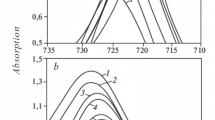Abstract
A brief review of the methods for determining the total base number (TBN) of engine oils is presented. This integral parameter characterizes the total content of basic impurities (additives) in terms of the amount of potassium hydroxides in one gram of engine oil (mg KOH/g). Spent engine oils are usually titrated by hydrochloric acid in a nonaqueous medium under controlled indicator electrode potential. It is revealed that the same technique can be successfully used in the analysis of commercial (fresh) oils. The titration curves are registered with an indicator glass electrode. The TBN values for fresh and spent engine oils are determined with approximately the same convergence (Sr < 2%). To check the compatibility of the determined TBN values, the limits of repeatability and reproducibility specified in GOST (State Standard) 11362-96 are used. Using the M-10G2 grade oil as an example, different variants of potentiometric titration are compared, the corresponding metrological characteristics are determined, and recommendations for testing laboratories are developed. The titration of oil to a certain fixed potential recommended by GOST 11362-96 results in underestimated TBN values as to compared to other variants used for revealing the equivalence point and leads to worsening of the reproducibility upon using weighed sample portions with different weights. It is recommended to determine TBN values for fresh or spent engine oils by means of potentiometric titration a using the three-tangent method. The accuracy of the obtained results is checked by the standard method of additives (spike recovery test), the error of determination being less than 15% (rel). It is shown by using Shewhart control charts that the metrological characteristics of the repeatability and reproducibility are stable, but the results of analysis for reference samples often are beyond the warning limits, especially for the samples of spent oil. Promising directions of further studies are proposed.



Similar content being viewed by others
REFERENCES
Novikov, E.A. and Kiryukhin, M.V., Analysis of oils during its use: an uncharted territory, Analitika, 2015, no. 3 (22), pp. 36–47.
Myalo, O.V., Myalo, V.V., and Keruchenko, L.S., The experimental diagnostics of high-alkaline motor oils by the “drop sample” method, Vestn. Omsk. Agrar. Univ., 2018, no. 4 (32), pp. 66–76.
Rozbakh, O.V., Quality control efficiency in oil analysis, Omsk. Nauchn. Vestn., 2006, no. 1, pp. 119–120.
Vereshchagin, V.I., Runda, M.M., Koval’skii, B.I., and Bezborodov, Yu.N., Metody kontrolya i rezul’taty issledovaniya motornykh masel dvigatelei vnutrennego sgoraniya v usloviyakh dlitel’nogo khraneniya i ekspluatatsii (Control Methods and the Results of Motor Oil Analysis for Long-Term Storage and Operation of Internal Combustion Engines), Krasnoyarsk: Sib. Fed. Univ., 2016.
Fitch, J. and Troyer, D., Oil Analysis Basics, Tulsa, OK: Noria, 2010, 2nd ed.
ISO 6618:1997: Petroleum Products and Lubricants—Determination of Acid or Base Number—Color-Indicator Titration Method, Geneva: Int. Stand. Org., 1997.
Laushkin, A.V. and Khaziev, A.A., Theoretical aspects of changing TBN of motor oil during the automobile transport exploitation, Transp. Transp. Sooruzh., Ekol., 2014, no. 1, pp. 88–94.
GOST (State Standard) 30050-93 (ISO 3771-77): Petroleum Products. Total Base Number. Perchloric Acid Potentiometric Titration Method, Moscow: Standartinform, 1995.
GOST (State Standard) 11362-96: Petroleum Products and Lubricants. Neutralization Number. Potentiometric Titration Method, Moscow: Standartinform, 1997.
ASTM D4739-17: Standard Test Method for Base Number Determination by Potentiometric Hydrochloric Acid Titration, West Conshohocken, PA: ASTM Int., 2017. https://doi.org/10.1520/D4739-17
Determination of Total Base Number (TBN) according to ASTM D2896/ISO 3771, Xylem, 2019. https://www.ysi.com. Accessed July 14, 2020.
Determination of the total base number in petroleum products, Metrohm Appl. Bull., 2017. https://metrohm-russia.ru/specials/thermometric/1360597_AB-405_1_ EN.pdf. Accessed July 12, 2020.
Fox, M.V., Pawlak, Z., and Picken, D.J., Acid-base determination of lubricating oils, Tribol. Int., 1991, vol. 24, no. 6, pp. 335–340. https://doi.org/10.1016/0301-679X(91)90003-R
Dong, J., van de Voort, F.R., Yaylayan, V., et al., Determination of total base number (TBN) in lubricating oils by mid-FTIR spectroscopy, Lubr. Eng., 2001, vol. 57, no. 11, pp. 24–30.
Martalov, A.S., Bratkov, A.A., and Samoshenkov, D.V., Determination of basic number of mineral engine oils with IR-spectroscopy using, Neftepererab. Neftekhim., 2007, no. 7, pp. 49–50.
Vershinin, V.I., Group formation and choice of standard substances in the determination of total concentrations of similar compounds as total indices, J. Anal. Chem., 2017, vol. 72, no. 9, pp. 947–956. https://doi.org/10.1134/s1061934817090131
GOST (State Standard) 8581-78: Motor Oils for Motor and Tractor Diesel Engines. Specifications, Moscow: Izd. Standartov, 2011.
ISO 7870-2:2013: Control Charts—Part 2: Shewhart Control Charts, Geneva: Int. Stand. Org., 2013.
Harvey, D., Modern Analytical Chemistry: Textbook, New York: McGraw-Hill, 2000, ch. 9.
ISO 6619:1988: Petroleum Products and Lubricants—Neutralization Number—Potentiometric Titration Method, Geneva: Int. Stand. Org., 1988.
Vershinin, V.I., Total indices as a tool to estimate sum content of similar analytes. Review, Talanta, 2015, vol. 131, no. 1, pp. 293–300. https://doi.org/10.1016/j.talanta.2014.07.102
Vershinin, V.I., Opredelenie summarnogo soderzhaniya odnotipnykh veshchestv (teoriya integral’nykh pokazatelei) (Determination of Total Content of Similar Substances: Theory of Integral Indices), Omsk: Omsk. Gos. Univ., 2016.
Funding
The results presented in this paper have been obtained under the financial support of Omsk State University within the scope of the project “Development of Methods for Structural-Group Analysis of Objects of Complex Composition without Separation into Components.”
Author information
Authors and Affiliations
Corresponding author
Additional information
Translated by O. Polyakov
Rights and permissions
About this article
Cite this article
Chikunova, A.S., Vershinin, V.I. Determining the Total Base Number of Engine Oils Using Potentiometric Titration. Inorg Mater 57, 1440–1446 (2021). https://doi.org/10.1134/S002016852114003X
Received:
Revised:
Accepted:
Published:
Issue Date:
DOI: https://doi.org/10.1134/S002016852114003X



